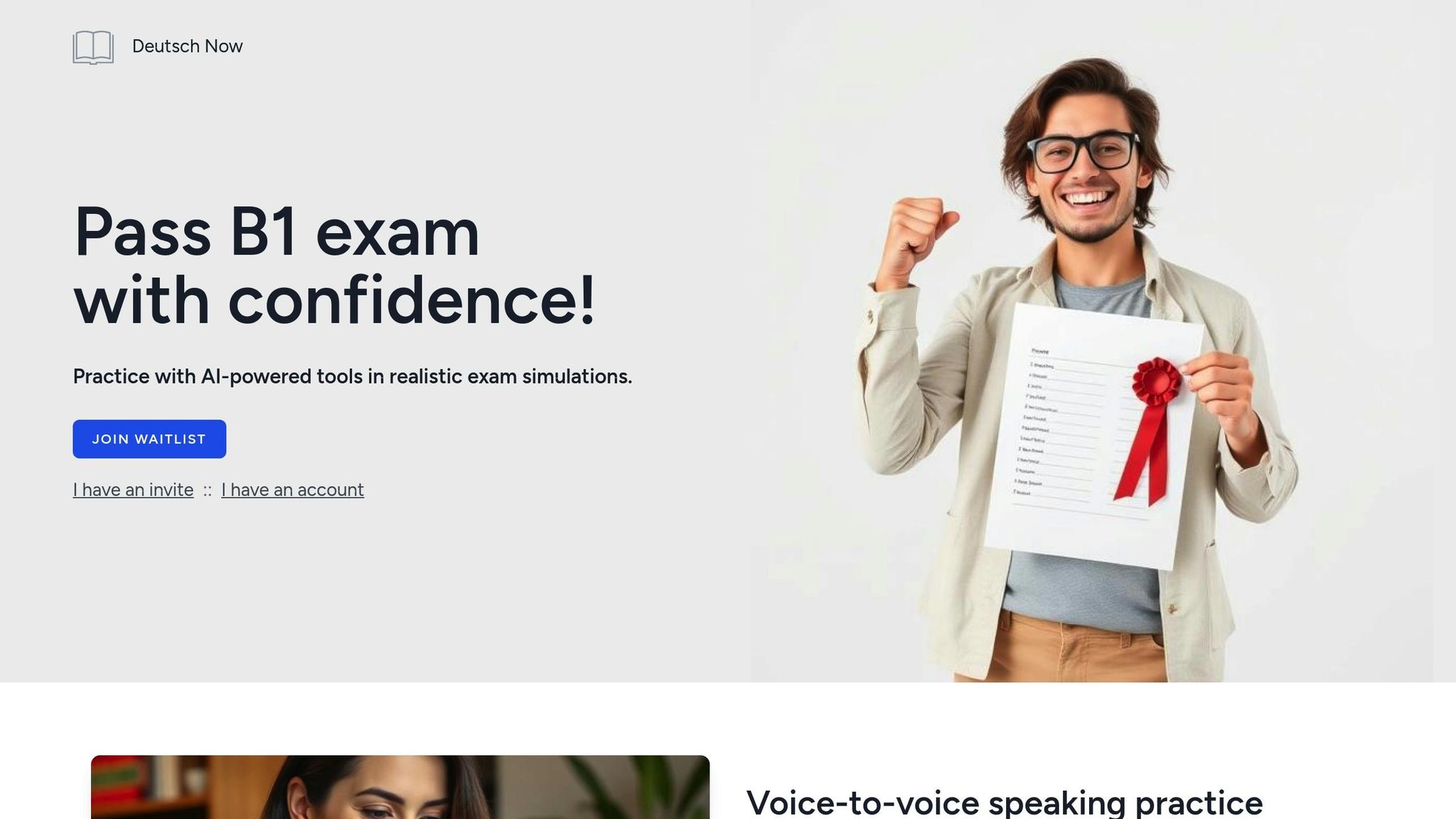
B1 German Reading Comprehension: Essential Practice Tips
Want to ace the B1 German reading test? Here's what you need to know:
- Test Format: 65 minutes, 5 parts, covering emails, articles, ads, and rules.
- Skills Tested: Understand main ideas, key details, and draw simple conclusions.
- Question Types: True/False, Matching Ads, and Multiple Choice.
Key Strategies:
- Expand Vocabulary: Learn 2,400 words using flashcards, context, and active recall.
- Practice with Real Texts: Use B1-level graded readers and authentic articles.
- Simulate the Test: Practice under timed conditions without dictionaries or phones.
Tools to Help:
- Deutsch Now ($24.90): Offers AI feedback, exam simulations, and progress tracking.
Focus on consistent practice, time management, and test-like conditions to improve your confidence and results.
B1 Reading Test Format
The B1 German reading test checks how well you understand everyday German.
What You’ll Need to Do
You’ll be asked to grasp main ideas, pick out important details, and make simple conclusions based on the text.
Types of Texts You’ll Encounter
- Blog entries: Personal stories and opinions
- Advertisements: Information about services or products
- Opinion pieces: Commentary on current events or topics
- Institutional texts: Rules, guidelines, or official notices
Question Formats
The test includes several question types to assess your reading skills [1]:
- True/False: Determine whether statements about the text are correct.
- Matching Ads: Match specific scenarios to ads. Use "0" if none apply.
- Multiple Choice: Choose the correct answer (a, b, or c).
Use these formats when practicing for the test to sharpen your skills!
Reading Practice Methods
To enhance your comprehension skills, focus on expanding your German vocabulary alongside practicing test formats.
Tips for Learning New Words
To meet the Goethe-Institut B1 requirement of 2,400 words [1], try these approaches:
- Learn words in context: Focus on collocations and common phrases to understand how words are used naturally.
- Use spaced repetition: Digital flashcards can help you review words at gradually increasing intervals, making them stick.
- Practice active recall: Dictate German audio, quiz yourself on texts, or rewrite and adapt passages using key terms.
After building your word bank, apply it by studying materials that include these words in real-world contexts.
Choosing Study Materials
Begin with B1-level graded readers for a structured introduction to new vocabulary. Once you're comfortable, move on to short authentic articles and stories to see words used in everyday scenarios.
Regular vocabulary practice directly improves your ability to tackle B1 reading tasks with confidence.
[1] Goethe-Institut. Requirement for at least 2,400 words at B1 level.
sbb-itb-e3b0fd6
Digital Learning Tools
Digital tools, alongside graded readers and other texts, can make B1 reading practice faster and more effective. They provide instant feedback, helping you identify problem areas and focus your efforts where it matters most.
B1 German Exam Practice – Deutsch Now Features

Deutsch Now includes several tools tailored for B1 reading practice:
- AI‑Powered Assessment: Get immediate feedback on your answers to see where you're falling short. The AI highlights tricky vocabulary clusters and directs you to revisit contexts where these words appear.
- Real Exam Simulations: Practice with authentic B1-level texts under timed conditions that mimic the actual test environment.
- Personalized Learning Path: The platform adapts to your performance, offering practice materials that target your weak spots. It also uses spaced repetition to reinforce new word combinations.
The Standard Plan, priced at $24.90, gives you full access to all reading comprehension tools. With this plan, you can:
- Work with texts modeled on official B1 exam formats
- Get detailed explanations for every answer
- Practice under time constraints similar to the real test
Progress Monitoring
Deutsch Now also includes tools to track your progress:
- Performance analytics that show which answers are correct and highlight patterns in your mistakes
These insights help you refine your study plan and focus on areas that need extra attention, keeping you on track to improve your B1 reading comprehension skills.
Test Day Preparation
Once you've been tracking your progress, it's time to concentrate on strategies for test day. Use your performance data to identify areas where you're struggling and practice those under timed conditions. On the day of the test, apply effective timing techniques and stress-management methods to make the most of your 65-minute reading period [1].
Time Management
Practice with full-length, timed mock tests to develop a steady pace. This helps ensure you can finish all questions without feeling rushed.
Staying Focused and Calm
Recreate exam conditions during practice - stick to strict timing and eliminate distractions. This approach can help ease anxiety and improve your focus on tough reading passages.
Summary
Mastering B1 reading comprehension involves three key steps: understanding the test format, practicing with intention, and preparing effectively.
Here are some strategies to help:
- Explore Different Texts: Work with a variety of text formats to get comfortable with the types of materials you'll encounter in the exam.
- Manage Your Time: Practice completing sections within a set time to ensure you can finish the exam on pace.
- Focus on Key Points: Learn to quickly spot main ideas and important details without getting distracted by unfamiliar words.
- Simulate Test Conditions: Practice in a test-like environment - no dictionaries or phones allowed - to build confidence and improve your timing [1].
Consistent practice in realistic conditions is the key to success.